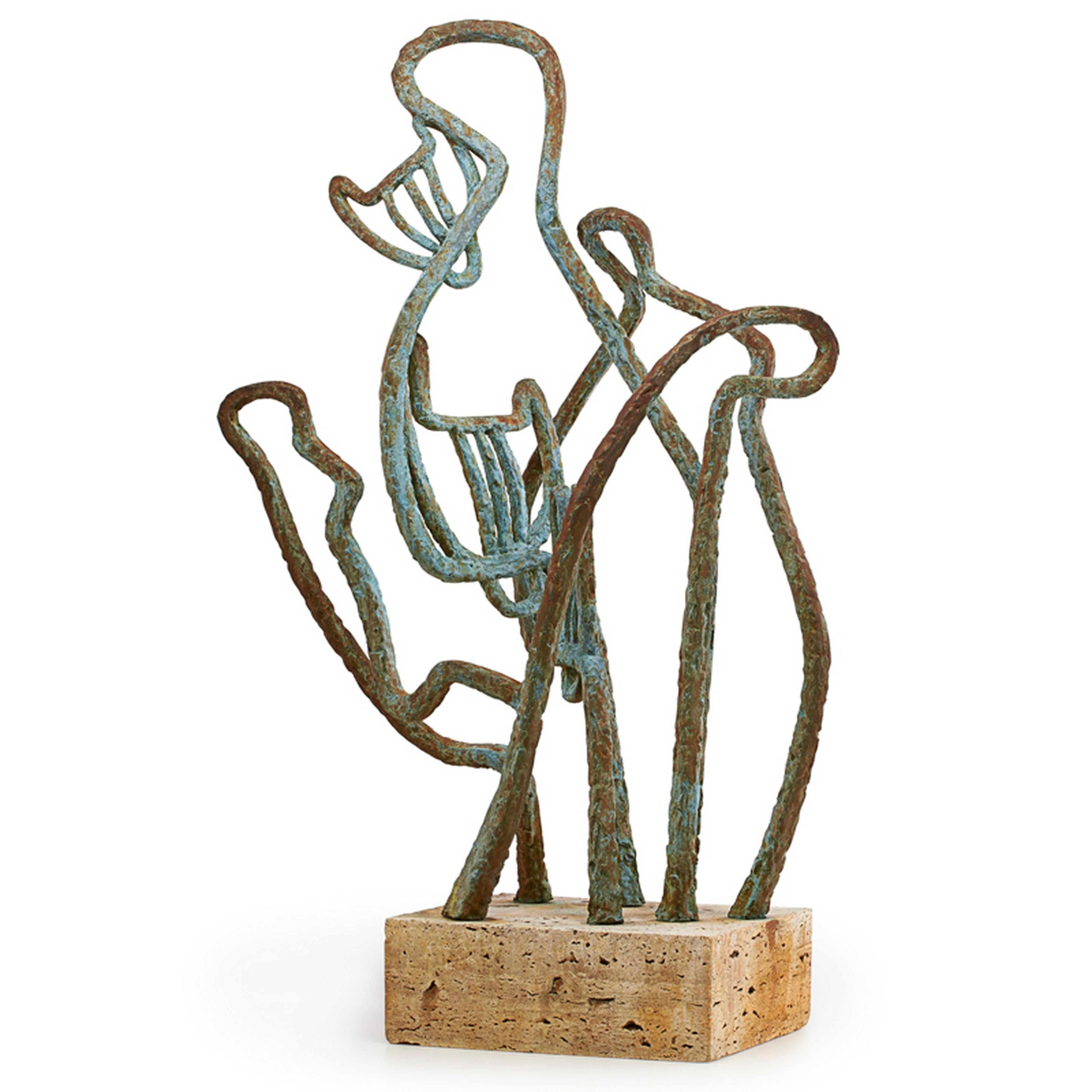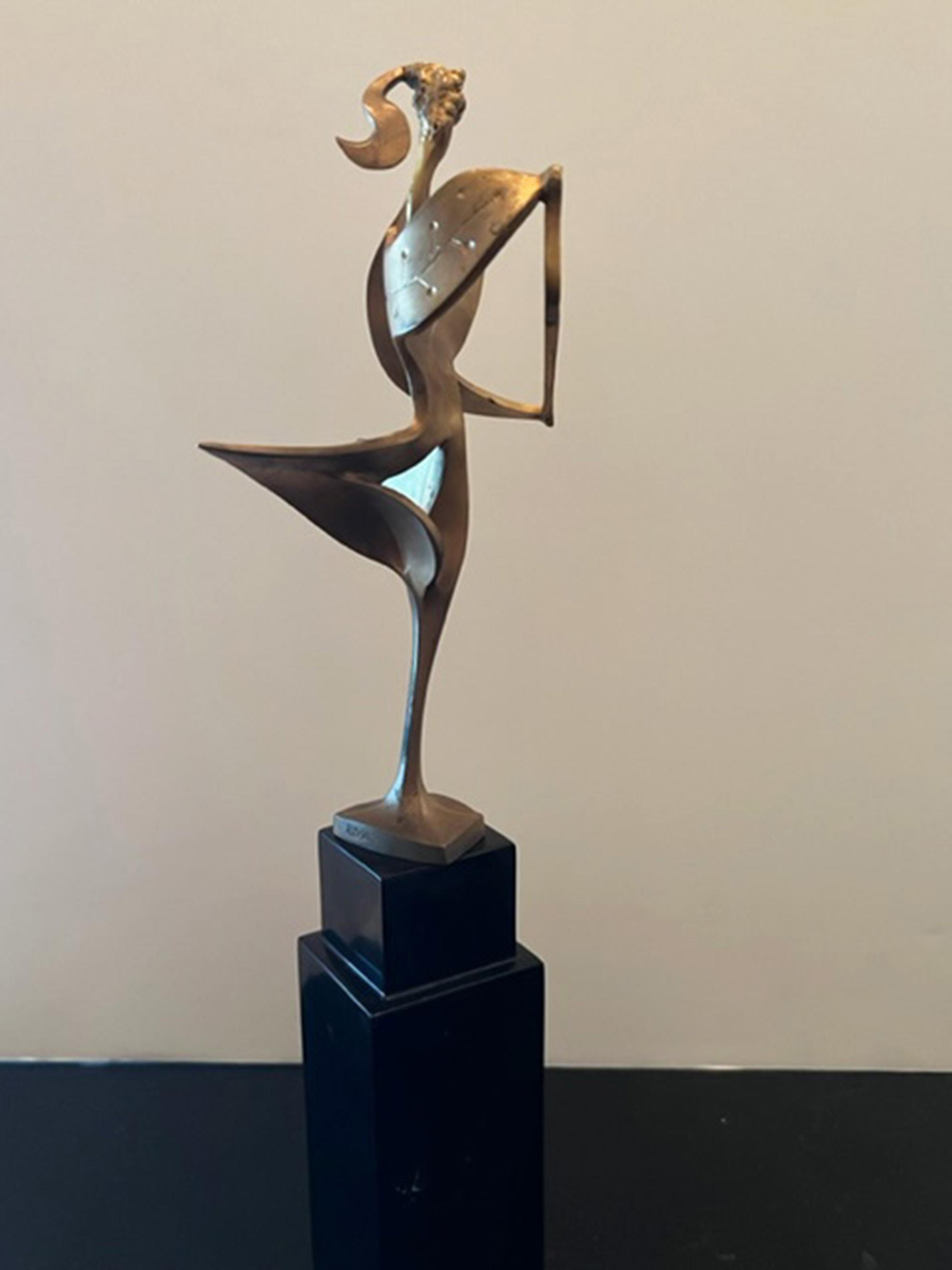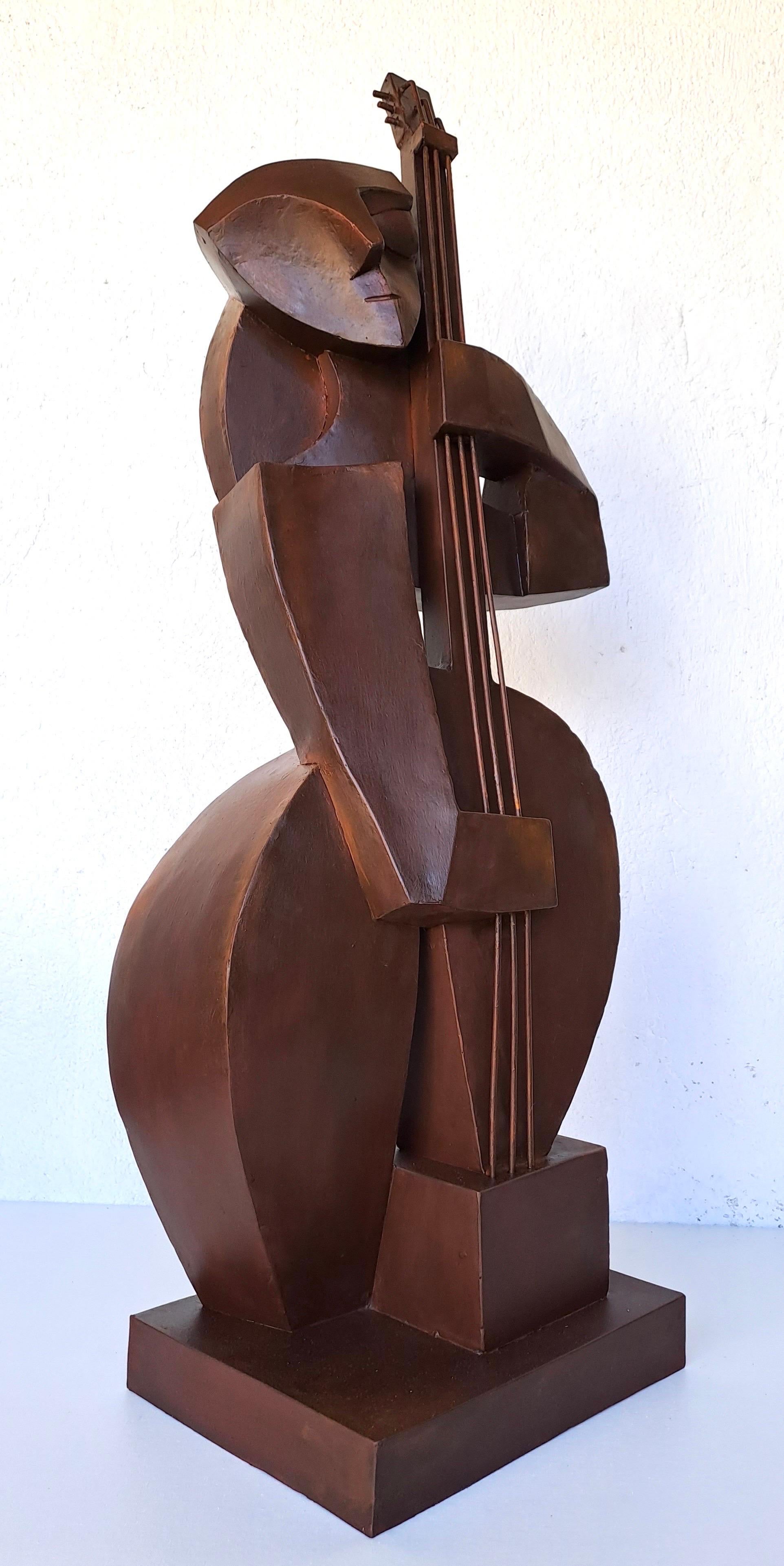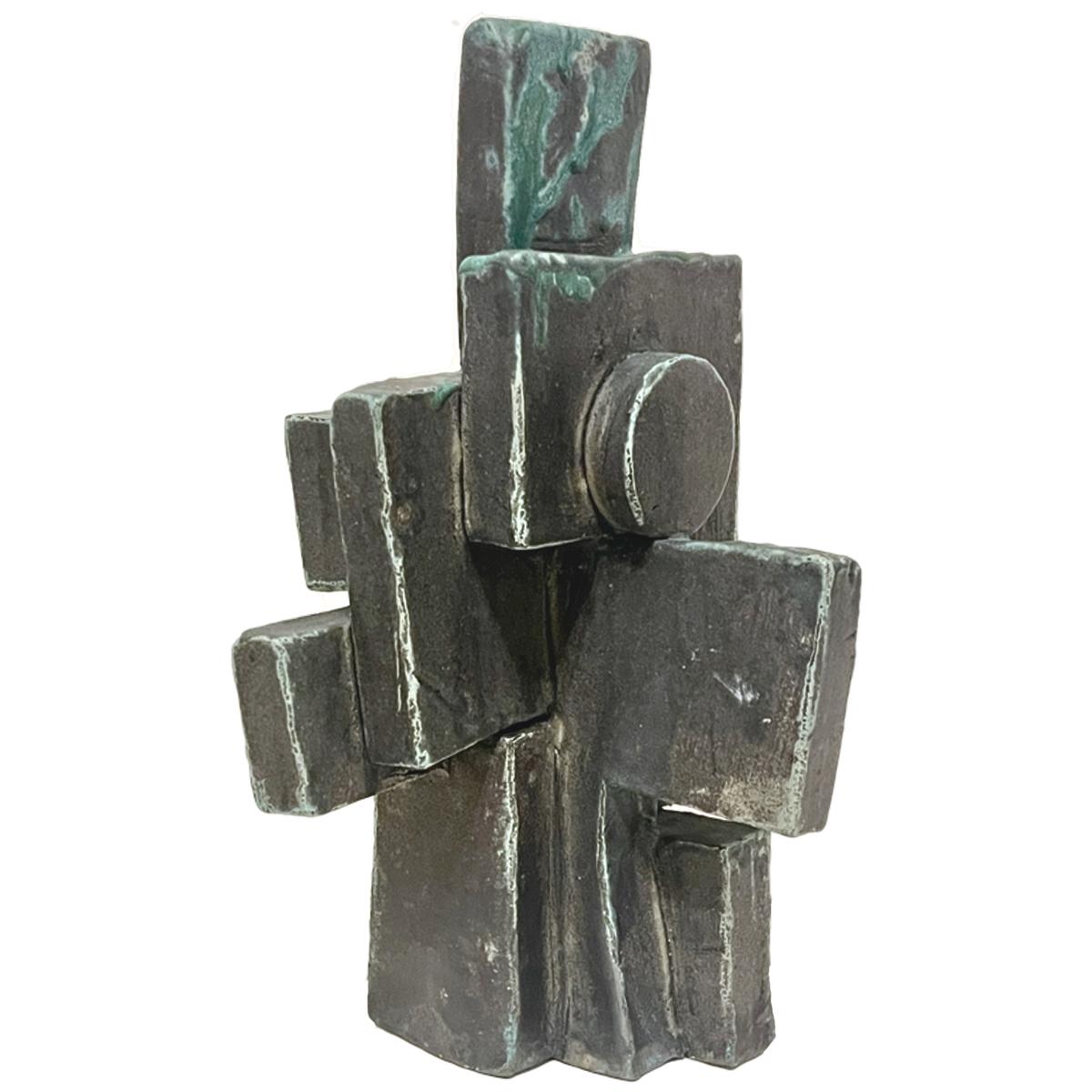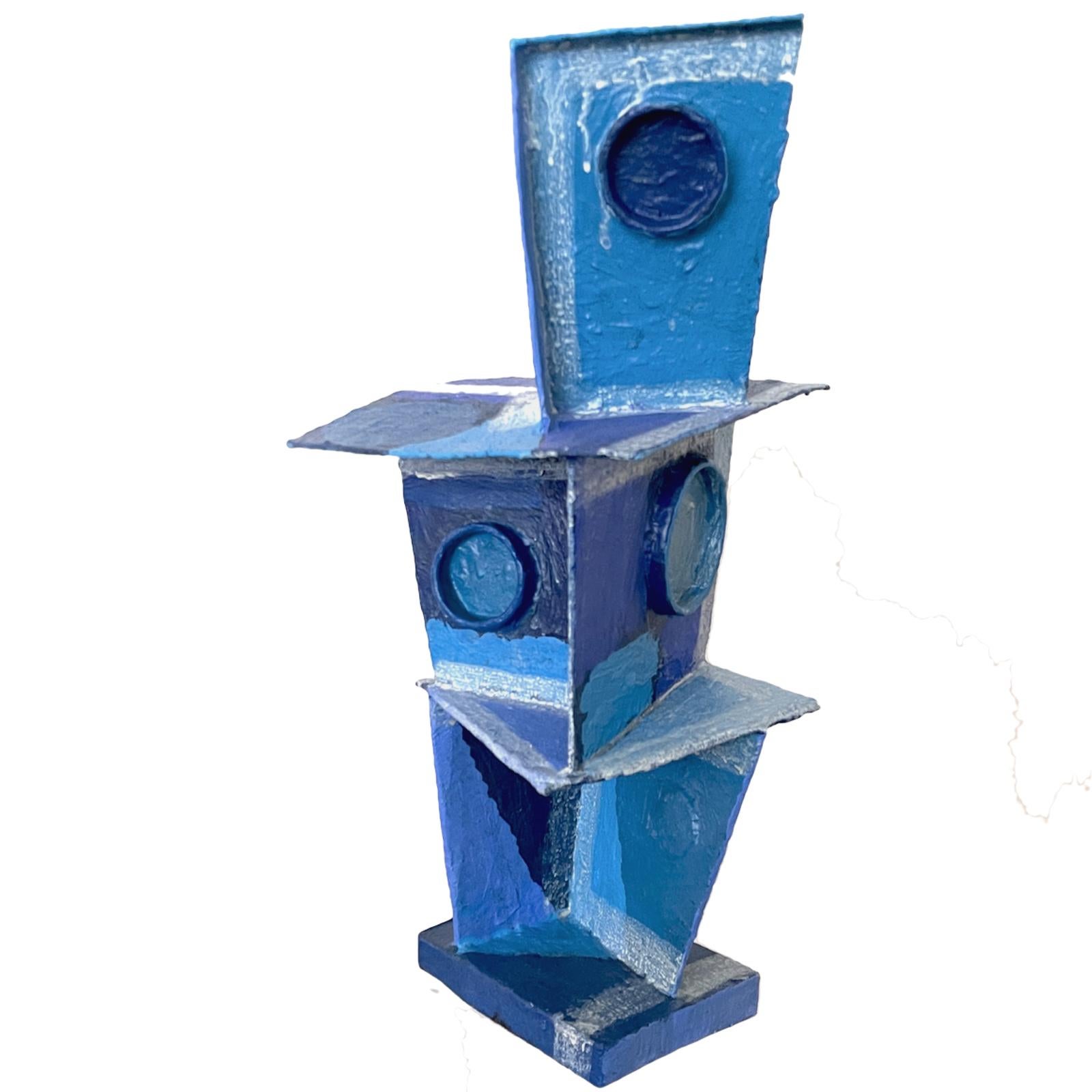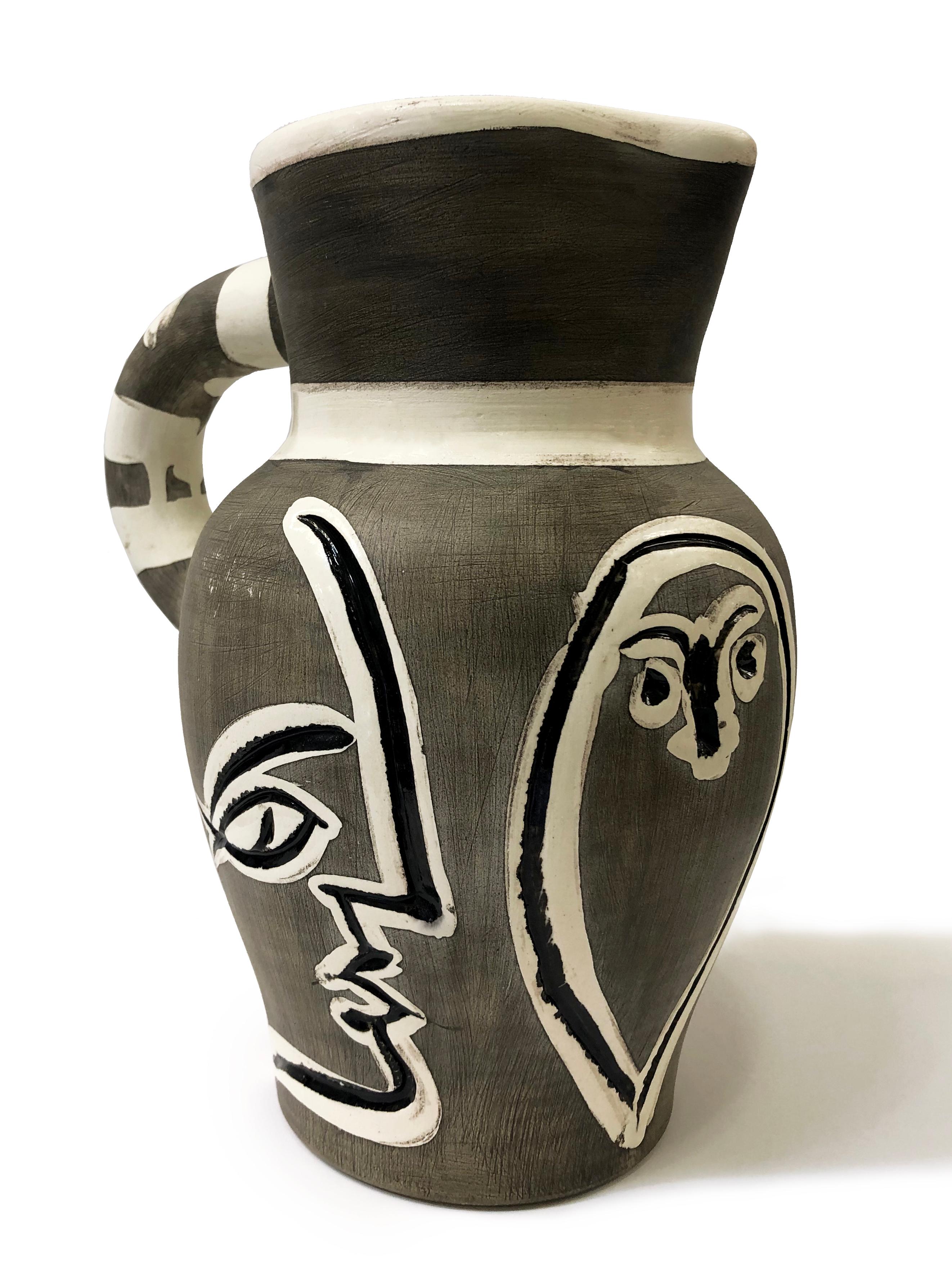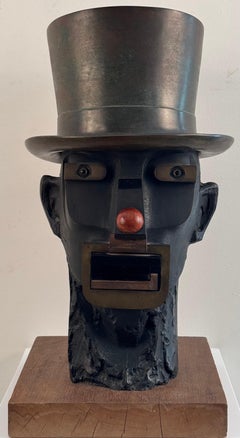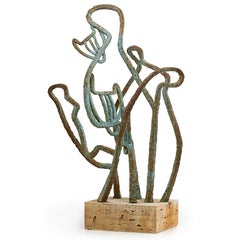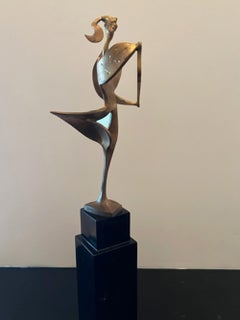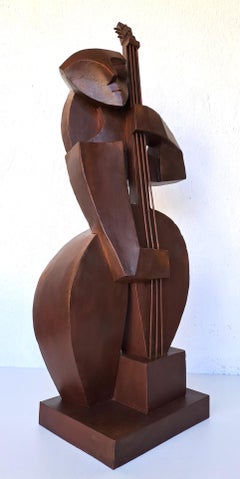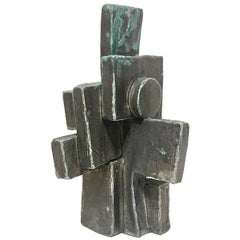Items Similar to "Petit masque découpé Montserrat", 20th Century Bronze by Julio González
Want more images or videos?
Request additional images or videos from the seller
1 of 8
Julio González"Petit masque découpé Montserrat", 20th Century Bronze by Julio GonzálezCirca 1930 - 1933
Circa 1930 - 1933
About the Item
JULIO GONZÁLEZ
Spanish, 1876 - 1942
PETIT MASQUE DÉCOUPÉ MONTSERRAT
signed "GONZALEZ"
5 of an edition of 9
Cire Perdue "C. VALSUANI" foundry seal
bronze
7-3/4 x 6-1/4 x 1-1/2 inches (19.5 x 15.8 x 4 cm.)
Mounted on wood: 11-3/4 x 7-3/4 x 1-3/8 inches (30 x 19.5 x 3.5 cm.)
NOTE:
THIS WORK IS INCLUDED IN THE CATALOG REASONED BY JULIO GONZÁLEZ, VOLUME IV, PAGE 100.
PROVENANCE
Collection Particulière, Madrid, Valsuani
Frax Foundation, Spain
EXHIBITED
Museum IVAM (Valencia´s Institute of Modern Art), Valencia, Spain
Biography
Julio González (21 September 1876 – 27 March 1942), born in Barcelona, was a Spanish sculptor and painter who developed the expressive use of iron as a medium for modern sculpture. He was from a lineage of metalsmith workers and artists. His grandfather was a goldsmith worker and his father, Concordio González, a metalsmith worker who taught him the techniques of metalsmith in his childhood years. His mother, Pilar Pellicer Fenés, came from a long line of artists.
Julio attended Circol Artist Sant Luc, a Catholic school whose model of education was based on the medieval art guilds and influenced by the Arts and Crafts movement in England.
Youth
Julio González was born in Barcelona, on September 21, 1876. He came from a line of metalsmith workers; his grandfather was a goldsmith in Galicia. González's father, Concordio González, owned a workshop and as a young boy, González learned from him the techniques of gold, silver, and iron metalwork. He and his older brother, Joan González, both studied these techniques. Further, all three González children studied at Circol Artist Sant Luc, a Catholic school that remodeled its education on the medieval art guilds, influenced by the Arts and Crafts movement in England. In 1896, González's father, died. The family workshop was passed onto the older son, Joan. With Joan directly involved with the family workshop, Joan and Julio focused on their metalwork techniques and artistic aspirations. By the end of the century, both brothers began to frequent visiting Els Quatre Gats, a café which was the meeting point of many artists, especially those related with modernisme. It was there where they met artists like Joan Miró and Pablo Picasso.
By the turn of the 20th century, Pablo Picasso and Julio González became great friends. González moved to Paris in 1902, but traveled to Barcelona several times in the early 20th century. At the Picasso Museum in Barcelona, their close friendship is verified by a drawn portrait, entitled "Julio González and the Robust Man Seen from Behind". They remained close friends until 1908; scholars do not know why their friendship ended at this time, but based on González archival materials, it appears to be related to previous dispute with Julio's brother, Joan.
Paris
In Paris he associated with the Spanish circle of artists of Montmartre, including Pablo Gargallo, Juan Gris and Max Jacob. In 1918, he developed an interest in the artistic possibilities of welding, after learning the technique whilst working in the Renault factory at Boulogne-Billancourt. This technique would subsequently become his principal contribution to sculpture, though during this period he also painted and —especially— created jewellery pieces. In 1920 he renewed his acquaintance with Picasso, for whom he later provided technical assistance in executing sculptures in iron, participating to Picasso's researches on analytic cubism. He also forged the infrastructures of Constantin Brâncuși's plasters. In the winter of 1927–28, he showed Picasso how to use oxy-fuel welding and cutting. When their friendship re-established itself, Picasso and González collaborated on a piece called Woman in the Garden between 1928–1930.[1] From October 1928 till 1932, both men worked together—and in 1932, González was the only artist with whom Picasso shared his own personal art notebook. Influenced by Picasso, the fifty-year-old González deeply changed his style, exchanging bronze for iron, and volumes for lines. González began to formalize a new visual language in sculpture that would change the course of his career.
Ironwork 1932–1937
González created ironwork at this time that would establish him as "the father of all iron sculpture of this century". During the early 1930s, few artists utilized forged or welded metal as a potential medium for their art. This is because, at the time, many artists did not directly work with the medium. Rather, artists worked with a foundry and expert technicians to execute the works of art. González was unique in this instance because his work demanded an active interaction- something that required the skills shaped by a long and specialized apprenticeship. In 1937 he contributed to the Spanish Pavilion at the World Fair in Paris (La Montserrat, standing near Guernica), and to Cubism and Abstract Art at the Museum of Modern Art in New York.
1938–1942: later years
As González aged between 1938 and 1940, he drew more. These later works, as scholar Joseph Withers states, “touch on larger problems and personal concerns which necessitated our discussion of these works in the context of González's evidently pessimistic reaction to the Spanish Civil War and the Second World War. Julio González was directly affected by the Second World War; his daughter Roberta González married German painter—and Julio's assistant—Hans Hartung in 1938. When the German invasion occurred in France, the couple had to separate from the rest of the family since Hans Hartung was an anti-Nazi and was wanted by the German secret police. While separated from his daughter and son-in-law, Julio Gonzalez drew figurative drawings and worked on plaster casts. The drawings and castings produced during the last two years of his life are testimonies to the suffering and despair Gonzalez felt towards tyranny and war. Julio Gonzalez died in Arcueil on March 27, 1942.
Public collections
The Art Institute of Chicago, the Cleveland Museum of Art, the Hirshhorn Museum and Sculpture Garden (Washington D.C.), the Honolulu Museum of Art, the Kröller-Müller Museum (Otterlo, Netherlands), the Los Angeles County Museum of Art, the Luís Ángel Arango Library (Bogotá, Colombia), the Mary and Leigh Block Museum of Art (Northwestern University, Evanston, Illinois), Musée des Beaux-Arts de Rennes (France), Museo Nacional Centro de Arte Reina Sofía (Madrid) Museo Patio Herreriano de Valladolid (Spain), Museu Nacional d'Art de Catalunya (Barcelona, Spain), the Museum of Modern Art (New York City), the Nasher Sculpture Center (Dallas, Texas), the National Gallery of Scotland (Edinburgh), the Peggy Guggenheim Collection (Venice), the Philadelphia Museum of Art, the Pompidou Center (Paris), the Solomon R. Guggenheim Museum (New York City), and the Tate Gallery (London) are among the public collections holding work by Julio González. The biggest collection of this artist's work is held by the IVAM (Valencia's Institute of Modern Art), in the city of Valencia, Spain, with close to 400 pieces.
Biography Julio González (21 September 1876 – 27 March 1942), born in Barcelona, was a Spanish sculptor and painter who developed the expressive use of iron as a medium for modern sculpture. He was from a lineage of metalsmith workers and artists. His grandfather was a goldsmith worker and his father, Concordio González, a metalsmith worker who taught him the techniques of metalsmith in his childhood years. His mother, Pilar Pellicer Fenés, came from a long line of artists.
Julio attended Circol Artist Sant Luc, a Catholic school whose model of education was based on the medieval art guilds and influenced by the Arts and Crafts movement in England. Ironwork 1932–1937 González created ironwork at this time that would establish him as "the father of all iron sculpture of this century". During the early 1930s, few artists utilized forged or welded metal as a potential medium for their art. This is because, at the time, many artists did not directly work with the medium. Rather, artists worked with a foundry and expert technicians to execute the works of art. González was unique in this instance because his work demanded an active interaction- something that required the skills shaped by a long and specialized apprenticeship. In 1937 he contributed to the Spanish Pavilion at the World Fair in Paris (La Montserrat, standing near Guernica), and to Cubism and Abstract Art at the Museum of Modern Art in New York. Public collections The Art Institute of Chicago, the Cleveland Museum of Art, the Hirshhorn Museum and Sculpture Garden (Washington D.C.), the Honolulu Museum of Art, the Kröller-Müller Museum (Otterlo, Netherlands), the Los Angeles County Museum of Art, the Luís Ángel Arango Library (Bogotá, Colombia), the Mary and Leigh Block Museum of Art (Northwestern University, Evanston, Illinois), Musée des Beaux-Arts de Rennes (France), Museo Nacional Centro de Arte Reina Sofía (Madrid) Museo Patio Herreriano de Valladolid (Spain), Museu Nacional d'Art de Catalunya (Barcelona, Spain), the Museum of Modern Art (New York City), the Nasher Sculpture Center (Dallas, Texas), the National Gallery of Scotland (Edinburgh), the Peggy Guggenheim Collection (Venice), the Philadelphia Museum of Art, the Pompidou Center (Paris), the Solomon R. Guggenheim Museum (New York City), and the Tate Gallery (London) are among the public collections holding work by Julio González. The biggest collection of this artist's work is held by the IVAM (Valencia's Institute of Modern Art), in the city of Valencia, Spain, with close to 400 pieces.
About the Seller
5.0
Vetted Professional Seller
Every seller passes strict standards for authenticity and reliability
Established in 1977
1stDibs seller since 2019
21 sales on 1stDibs
Typical response time: 4 hours
- ShippingRetrieving quote...Shipping from: Madrid, Spain
- Return Policy
Authenticity Guarantee
In the unlikely event there’s an issue with an item’s authenticity, contact us within 1 year for a full refund. DetailsMoney-Back Guarantee
If your item is not as described, is damaged in transit, or does not arrive, contact us within 7 days for a full refund. Details24-Hour Cancellation
You have a 24-hour grace period in which to reconsider your purchase, with no questions asked.Vetted Professional Sellers
Our world-class sellers must adhere to strict standards for service and quality, maintaining the integrity of our listings.Price-Match Guarantee
If you find that a seller listed the same item for a lower price elsewhere, we’ll match it.Trusted Global Delivery
Our best-in-class carrier network provides specialized shipping options worldwide, including custom delivery.More From This Seller
View AllRamoneur IV
By Eduardo Arroyo
Located in Madrid, ES
EDUARDO ARROYO
Spanish, 1937 - 2018
RAMONEUR IV
signed, dated and numbered "ARROYO / 1982 / 1/6" (on the side of the neck)
"MAGISA" foundry seal (on the side of the neck)
bronze and ...
Category
1980s Cubist Figurative Sculptures
Materials
Bronze
"A Girl Bust" 20th Century Bronze Sculpture by Spanish Artist Juan Clará Ayats
Located in Madrid, ES
JUAN CLARÁ AYATS
Spanish, 1878 - 1958
A GIRL BUST
signed "Juan Clara" and Buenos Aires stamp mark (on the back )
bronze figure
6-3/8 x 4-1/8 x 4-1/8 inches (16 x 10.5 x 10.5 cm.)
8 x 4-1/8 x 4-1/8 inches (20 x 10.5 x 10.5 cm.) base included
PROVENANCE
Private Spanish Collector
Art Noveau bronze...
Category
1920s Art Nouveau Figurative Sculptures
Materials
Bronze
"A Girl Sitting on a Stool Tying Her Shoe", 20th Century Bronze by Juan Clará
Located in Madrid, ES
JUAN CLARÁ AYATS
Spanish, 1878 - 1958
A GIRL SEATED ON A STOOL TYING HER SHOE
signed "Juan Clara" and stamped A.G. Paris and marks L.R. 213 (on the stool )
bronze figure
6-3/8 x 3 x 4 inches (16 X 7.5 X 10 cm.)
PROVENANCE
Private Collector, Madrid
A brown patia bronze sculpture of Art Nouveau style, depicting a little girl sitting on a sidewalk tying her shoe.
The plasticity that Juan Clará achieves with the bronze when shaping this beautiful little sculpture is wonderful. We notice the effort that the little girl is making to put on her shoe, her gestures and attitudes which moves us and attracts us towards her.
Juan Clará Ayats. Olot (Gerona), 6.XII.1875 - Paris (France), II.1958. Sculptor
Student of José Berga at the Olot School of Fine Arts, developed his training in France, first at the School of Fine Arts in Toulouse, in 1896, and from 1901 in Paris. At this stage he lived with his younger brother, José Clará...
Category
1920s Art Nouveau Figurative Sculptures
Materials
Bronze
"Art Nouveau Sculptural Bronze Group of Children", 20th Century by Juan Clará
Located in Madrid, ES
JUAN CLARÁ AYATS
Spanish, 1878 - 1958
ART NOUVEAU BRONZE GROUP OF CHILDREN
signed "Juan Clara" (lower right on the bench)
bronze sculpter group
4-3/4 x 6 x 3-1/2 inches (12 X 15 X 9 cm.)
PROVENANCE
Private Spanish Collector
Juan Clará's Art Nouveau bronze sculptural group representing two boys and a girl sitting on a bench in a funny and surprise attitude to something they are seeing.
Juan Clará's Art Nouveau bronze sculptural group representing two boys and a girl sitting on a bench in a funny and surprise attitude to something they are seeing.
Juan Clará Ayats. Olot (Gerona), 6.XII.1875 - Paris (France), II.1958. Sculptor
Student of José Berga at the Olot School of Fine Arts, developed his training in France, first at the School of Fine Arts in Toulouse, in 1896, and from 1901 in Paris. At this stage he lived with his younger brother, José Clará...
Category
1920s Art Nouveau Figurative Sculptures
Materials
Bronze
"A Girl Sitting on a High Chair" 20th Century Bronze Sculpture by Juan Clará
Located in Madrid, ES
JUAN CLARÁ AYATS
Spanish, 1878 - 1958
A GIRL SITTING ON A HIGH CHAIR
signed "Juan Clara" (on the back of the chair )
bronze figure
8-3/4 x 7-1/8 x 4-3/4 inches (22 X 18 X 12 cm.)
PROVENANCE
Private Spanish Collector
A young girl sitting on a high chair, with a naughty attitude that wants to escape from the high chair.
She is making a great effort to get rid of the bars of the high chair, just as her whole body accompanies her to this effort.
The candid and innocent attitude of the girl, but at the same time fun and mocking we love and conquer.
Juan Clará Ayats. Olot (Gerona), 6.XII.1875 - Paris (France), II.1958. Sculptor
Student of José Berga at the Olot School of Fine Arts, developed his training in France, first at the School of Fine Arts in Toulouse, in 1896, and from 1901 in Paris. At this stage he lived with his younger brother, José Clará...
Category
1920s Art Nouveau Figurative Sculptures
Materials
Bronze
"Art Nouveau Bronze Sculptural of a Boy and Girl", 20th Century by Juan Clará
Located in Madrid, ES
JUAN CLARÁ AYATS
Spanish, 1878 - 1958
ART NOUVEAU SCULPTURAL BRONZE OF A BOY AND GIRL
signed "Juan Clara" (on the lower left )
sculptural bronze
4-3/8 x 4-3/8 x 3-1/2 inches (11 X 11 X 9 cm.)
PROVENANCE
Private Spanish Collector
Art Nouveau Bronze sculpture representing a boy and a girl sitting on a stool in a funny and surprised attitude to something they are seeing. Sgned "Juan Clará" lower left with the foundry seal and marks on the right side of the bench
Juan Clará Ayats. Olot (Gerona), 6.XII.1875 - Paris (France), II.1958. Sculptor
Student of José Berga at the Olot School of Fine Arts, developed his training in France, first at the School of Fine Arts in Toulouse, in 1896, and from 1901 in Paris. At this stage he lived with his younger brother, José Clará...
Category
1920s Art Nouveau Figurative Sculptures
Materials
Bronze
You May Also Like
Abstract Signed Cubist Bronze Sculpture "Cats" Chicago Bauhaus Woman Modernist
Located in Surfside, FL
This listing is just for the sculpture. (the picture of the ad is for reference and is not included.)
Marie Zoe Greene-Mercier was an artist, writer and arts activist who worked in t...
Category
1960s Cubist Abstract Sculptures
Materials
Travertine, Bronze
Primavera
By Robert Russin
Located in West Hollywood, CA
We are proud to present an original very early bronze, (1958) by American sculptor Robert Russin.
Robert Russin began his career as a WPA sculptor, and received dozens of commission...
Category
1950s Cubist Figurative Sculptures
Materials
Bronze
Price Upon Request
"BAJISTA"
By Ulises Jimenez Obregon
Located in Los Angeles, CA
ULISES JIMENEZ
"BAJISTA"
METAL, SIGNED
COSTA RICA, 2023
32.25 INCHES
Ulises Jiménez Obregón was born in La Mansion de Nicoya, Costa Rica, in November 1953.
He studied Plas...
Category
2010s Cubist Figurative Sculptures
Materials
Metal
Tall Weathered Bronze Ceramic Abstract Cubist Brutalist Totem Sculpture
By Judy Engel
Located in Hudson, NY
Hand built heavily glazed solid ceramic structure by NY artist Judy Engel.
Solid slabs create this cubist style sculpture that Engel is recognized for. Greatly influenced by the modernism of the middle of the 20th century, Judy's first introduction to this style was the Empire State Plaza in Albany, NY. "In the 1970s, upstate school kids...
Category
21st Century and Contemporary Cubist Abstract Sculptures
Materials
Ceramic, Glaze
'Blue Tone Tower': Modernist Vibrant Blues Cubist Sculpture by Bill Low
By Bill Low
Located in Hudson, NY
Cubist style abstract mixed-media sculpture titled 'Blue Tone Tower' was created using various materials including wood, papier-mache, and paint by Bill Low ...
Category
Mid-20th Century Cubist Abstract Sculptures
Materials
Wood, Paint, Paper
Pichet Gravé Gris (Ceramic Pitcher)
By Pablo Picasso
Located in Aventura, FL
White earthenware ceramic pitcher painted in black, white and grey patina with knife engraving and partial brushed glaze. Inscribed 'Edition Picasso' in black and with the Edition P...
Category
1950s Cubist Figurative Sculptures
Materials
Ceramic, Earthenware
$31,600 Sale Price
20% Off
Recently Viewed
View AllMore Ways To Browse
Worker Bronze
Brancusi Like Sculptures
Hans Muller Bronze
French Angel Sculpture
French Cast Iron Sculpture
Cast Metal Garden Sculptures
Sculpture Plaster 1940
Spanish Jewelry Barcelona
Medieval Wood Sculpture
Large Boy Bronze
Catholic Bronze
Used Jewelry Dallas
1876 Jewelry
Petit Jacob
1930s Iron Patio
Muller Bronze Sculpture
Bronze Jewelry Mens
Vintage Renault
